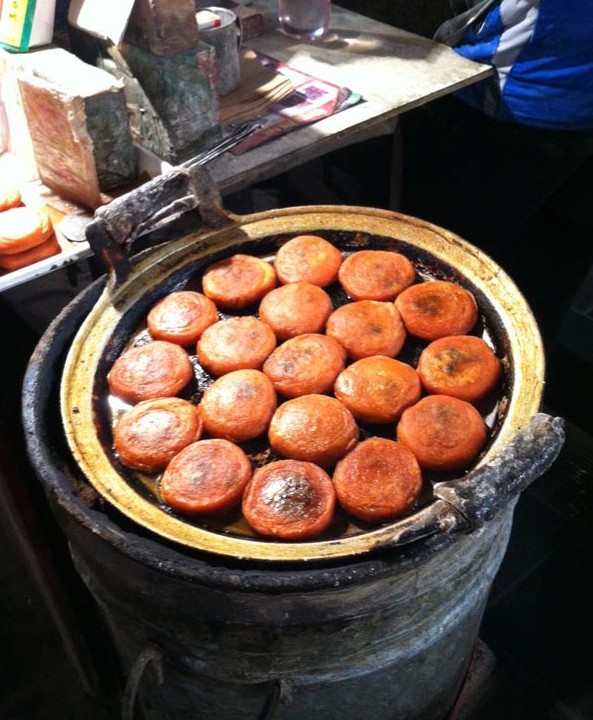By Josephine Hyde (Josephine)
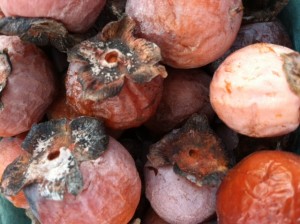 Persimmons abound in Midwestern farmers’ markets during the fall. One need not travel to Xi’an, nor set aside the practice of locavorism to eat shi zi bing. According to Purdue’s horticulture website, “Mature, hard, astringent persimmons can be stored in the refrigerator for at least a month. They can also be frozen for 6 to 8 months.” Alternatively, one can process the ripe fruit and freeze the purée for up to a year.
Persimmons abound in Midwestern farmers’ markets during the fall. One need not travel to Xi’an, nor set aside the practice of locavorism to eat shi zi bing. According to Purdue’s horticulture website, “Mature, hard, astringent persimmons can be stored in the refrigerator for at least a month. They can also be frozen for 6 to 8 months.” Alternatively, one can process the ripe fruit and freeze the purée for up to a year.
To be palatable, most persimmons should be dead-ripe. To hasten the process, wrap the fruit in paper or enclose along with apples or pears to encourage the development of ethylene, the natural ripening agent.
Allow the Hachiya variety to soften and become wrinkly. This mitigates the astringent quality of its flesh. The Fuyu persimmon is sweeter than the Hachiya, and has a complex floral aroma. The Fuyu does not need to be mushy to be eaten. A fresh persimmon weighs about 168 grams.
For an authentic taste of Xi’an, snack on some dried persimmons while you make the cakes. I found dried persimmons in my local Korean grocery, where I asked for gotgam and was directed to the freezer section. The fresh and dried fruits can be found in Japanese groceries as hoshigaki and Vietnamese groceries as hồng khô. Allow the frozen persimmons to stand at room temperature for 20 minutes, and you will find them to be softer than most dried fruit.
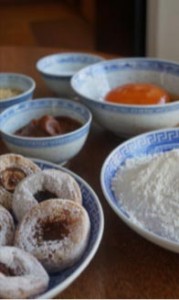 I adapted both amounts of ingredients and directions from this recipe on the website of Australia’s multi-cultural Special Broadcasting Service.
I adapted both amounts of ingredients and directions from this recipe on the website of Australia’s multi-cultural Special Broadcasting Service.
Ingredients
For the walnut filling:
1/3 c. superfine sugar (I used C&H Baker’s Sugar)
1½ – 3 t. rosewater (I used Ziyad brand)
1½ t. water
¼ cup finely chopped walnuts
For the persimmon cakes:
1¼ cups (286 g approx.) skinless persimmon purée (see note below for directions)
1½ cups all-purpose flour
Canola Oil
Method
1. Make the walnut filling. Combine rosewater and sugar, adding enough water to form a dryish paste. Toast walnuts over low heat in a small skillet just until you begin to smell them, before they begin to color. Combine walnuts and sugar mixture and set aside.
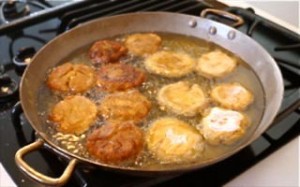 2. Make the dough. Combine persimmon purée and flour in a bowl to achieve a wet, sticky dough such as one for drop biscuits. The dough will look glossy. Cover bowl with plastic wrap and set aside for at least ½ hour in refrigerator.
2. Make the dough. Combine persimmon purée and flour in a bowl to achieve a wet, sticky dough such as one for drop biscuits. The dough will look glossy. Cover bowl with plastic wrap and set aside for at least ½ hour in refrigerator.
3. Form the cakes. Very generously flour a board or other work surface. Gather dough from bowl, and drop in one piece onto floured surface. The dough will be very soft, but the additional flour will allow it to be manipulated and fashioned into a log the thickness of a rolling pin, about 2″ in diameter.
4. With a sharp knife, cut the log into 10 pieces.
5. Form the cakes by gently rolling each piece out into a circle 3 inches in diameter, as you would a dumpling skin. Sprinkle a bit more flour on the piece of dough if necessary to prevent sticking (use the side of a glass as I did, a small rolling pin, or dowel, if you have one.) Press the edges of each round with your fingers to make it slightly thinner at the edges. Depending on how much flour adheres to each round of dough, you may need to wet the edges as you would a dumpling wrapper, in order to close them properly around the filling.
6. Place into the center of each round of dough about ½ t. of the walnut mixture.
7. Enclose walnut filling by bringing edges of dough together in center as you would for a soup dumpling, but without the fancy folds. Press to seal. The cakes will be shaped like little domes at this point. They will flatten as they cook in the oil.
8. Set prepared cakes on floured board. Repeat process with remaining dough and filling.
9. Fry the cakes, First, pour canola oil into a large skillet over medium-low heat. The level of the oil will rise when you have filled the skillet with the cakes, so start off with about 5/8″ of oil. Heat oil over medium heat.
10. Load a spatula with a single cake. Carefully slide and push cakes off end of a dry spatula with a wooden spoon into hot oil, taking care not to splash. Add more cakes to fill pan. The cakes should not be submerged in the oil; the surface of each cake should be above the oil.
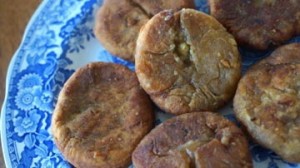 11. As cakes begin to cook, press them down gently with your spatula. They will slowly turn a beautiful golden orange color. If they begin to brown, the oil is too hot. Regulate the heat so that the cakes cook thoroughly but slowly. After about 5-7 minutes, turn each cake with tongs, to cook on the flip side.
11. As cakes begin to cook, press them down gently with your spatula. They will slowly turn a beautiful golden orange color. If they begin to brown, the oil is too hot. Regulate the heat so that the cakes cook thoroughly but slowly. After about 5-7 minutes, turn each cake with tongs, to cook on the flip side.
12. In another 5-7 minutes, test one cake to see if the center remains light yellow in color, or whether it has darkened slightly to the dark golden shade of the cooked exterior of the cake. This indicates doneness. DO NOT TEST DONENESS BY TASTING NOW! The molten sugar-walnut center will be palate-scalding hot.
13. As cakes begin to look uniformly done, but before they brown, remove to drain on paper towels. Wait at least 5 minutes, and test for temperature before you eat them.
14. Consume when warm.
Note on Persimmon Purée:
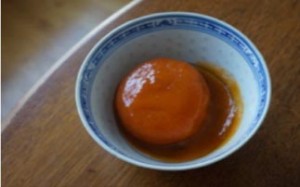 To make 1¼ cups of persimmon purée, purchase 3 Hachiya or 5 Fuyu persimmons. Depending on the size of the fruit, you may have some left over. A medium-size ripe Hachiya persimmon weighs about 168 grams; a Fuyu weighs somewhat less, around 138 g.
To make 1¼ cups of persimmon purée, purchase 3 Hachiya or 5 Fuyu persimmons. Depending on the size of the fruit, you may have some left over. A medium-size ripe Hachiya persimmon weighs about 168 grams; a Fuyu weighs somewhat less, around 138 g.
Stem and peel the ripe, fresh persimmons. Halve them, and scrape flesh into a bowl, making sure to remove any stubborn bits of skin. Put flesh into processor or blender, and process a few seconds until any lumps are removed. Although there will be some visible fibers, these should not be bothersome in the finished cakes if you have processed the purée in a food processor or blender. However, if you like, strain the purée to eliminate the fibers. You will need 1 ¼ cups (280 grams) of fruit (about 3-5 ripe persimmons, depending on type and size.)
The purée may successfully be frozen without a loss of flavor for up to a year. Though it may darken in color, this will not affect the taste or color of the finished cake.
Josephine Hyde (Josephine) is a longtime contributor to LTHForum.com. She believes that food is a portal to insight, connection, and joy.


